Fresh cucumbers add a fresh, light flavor to salads, but they’re also a great addition to smoothies. And of course, they’re the main ingredient in a variety of pickle recipes. Here’s what you need to know about growing pickling cucumbers or cukes for fresh eating, from temperature requirements to cucumber watering.
When you’re harvesting lots of cukes, be sure to try this easy refrigerator bread and butter pickle recipe or these refrigerator dill pickles.
Originally published February 2018; this post has been updated.
Growing Cucumbers
Cucumbers are common to find in many a backyard vegetable garden or kitchen garden across the country, and it’s easy to see why. Cucumbers are fairly easy to grow – all you need is a warm growing season, plenty of moisture, and lots of sunlight.
They perform best in southern states, but with a little patience, cucumbers can thrive in many parts of the country.
New to gardening? Limited on space? The 5-Gallon Garden gives you the skills you need to grow food in the space you have. Get started with your garden today!
Introduction to the Cucumber Plant
Like many garden crops, cucumbers come with a variety of things to consider when you’re planning your garden. Commonly known as cucumber, the Cucumis sativus plant is a member of the Cucurbitaceae family (also referred to as cucurbits).
Grow Some Greens!
Ready to grow fresh greens, no matter WHERE you live? Sign up for my
FREE quick-start guide and start growing some of your own food!
Other garden crops that belong to the Cucurbitaceae family include zucchini, pumpkin, and squash.
First things first: Is a cucumber a fruit or vegetable?
It’s the million dollar question, isn’t it? We plant these prolific plants in our vegetable gardens. We eat them on vegetable platters. But technically speaking, is a cucumber a fruit or vegetable?
Cucumbers have seeds, and they are edible, thus cucumber is a fruit. Cucumbers — the fruit of the Cucumis sativus plant — fit the description of a fruit.
But while a cucumber is a fruit technically speaking, when’s the last time you saw them served on a fruit platter? Rather, cucumbers are better suited for use in savory recipes [like this one] or served with dip or sliced onto a green salad.
I don’t know about you, but I’m going to continue to use them like a vegetable even though a cucumber is a fruit.
Slicing or Pickling Cucumbers?
Most cucumbers fall into one of two categories – slicing cucumbers or pickling cucumbers. Slicing cucumbers are larger, longer varieties best suited for salads and snacking.
Pickling cucumbers, as you’d guess from the name, are perfect for preserving. They can be considerably smaller than slicing cucumbers and have bumpier, thicker skins than other varieties. They hold up well to the process of pickling, resulting in a crispy, crunchy pickle.
The Best Cucumbers for Pickling
All cucumbers can be pickled, but there are some varieties that are considered the best cucumbers for pickling. These include:
- Picklebush
- Parisan
- Kirby
- County Fair
- Carolina
Bush or Vining Cucumbers?
You’ll need to determine what you want to do with your cucumbers before you choose your seeds, as this will guide your decision in what to plant. Aside from deciding which variety you’d like to grow, you’ll also need to choose the type of cucumber plant you grow when selecting your seeds: bush cucumbers or vine cucumbers.
Bush types of cucumbers take up much less room in your garden and can even be grown in a pot. They’re ideal for gardeners who have a small garden space. [More on container gardening here.]
More common, however, are vine cucumbers. Vine cucumbers grow well along the ground, but they’re an ideal candidate for trellising.
It requires a bit of extra work, but cucumbers grown on a trellis are typically more uniform in color and shape, and they won’t take up as much real estate in your garden bed.
Greenhouse Cucumbers
I grow solely greenhouse cucumbers, in order to avoid damage from pickleworms. By excluding the night-flying moth that lays eggs on the plants, I can have a regular and bountiful harvest.
Growing cucumbers in a greenhouse means I’m also excluding pollinators, so it’s important to choose parthenocarpic varieties. These varieties maintain fruit production without pollination. I do have to buy seeds every year, as seed saving is not an option.
I’ve had very good luck with the picolino variety, a greenhouse type of cucumber.
Starting Cucumber Seeds
This warm weather crop is often planted directly in the garden in late spring, after the last frost date.
Cucumber seeds can handle daytime temperatures between 65-90 degrees, but they germinate quickest when temperatures range between 80-90 degrees. Because of the temperature requirement, some people choose to start their cucumber plants indoors to get a head start on garden season and migrate them outside once it’s warm enough.
Start seeds in a good seed starting mix 4-6 weeks before your last frost date. Since cucumbers prefer warm temperatures, the seeds will benefit from a heat mat and grow light. Avoid letting the soil dry out, to prevent plant stress and give them a strong start.
Cucumber Seedlings
Because cucumber plants are easy to start from seed, they are less commonly available in nurseries. If you do find them, look for seedlings with good green coloring and avoid those that have flowers or fruit on them.
When preparing to plant cucumbers, you should always consider the temperature. Don’t plant your cucumbers while any chance of frost remains – be patient. Aim for a consistent soil temperature of 70 degrees before you plant.
Putting cucumber transplants in a home garden bed raised several inches from the ground can increase the temperature of the soil by a few degrees – enough to make a difference so that you can plant them out a bit earlier.
Requirements for Growing Cucumbers
Light Requirements
Whether you choose to plant a cucumber perfect for pickling or select a variety better-suited for slicing, they follow the same guidelines for growth. Cucumber plants need lots of sunlight – ideally, full sun exposure. This goes for both pickling cucumbers and those you’ll use for slicing.
Soil Requirements
Cucumbers grow best in fertile soil, so you’ll want to enrich the earth with well-rotted manure or compost prior to planting for a healthy boost. Consider natural fertilizers if you think your cucumbers could use a little extra encouragement.
Water Requirements
It’s important to ensure your cucumbers receive consistent water. Provide good drainage and maintain steady soil moisture without overly saturating the ground. This helps to prevent bitter cucumbers. Focus your cucumber watering efforts on the roots and avoid the leaves when you can, as moist leaves can lead to disease.
Spacing Cucumbers
Vining cucumbers need a fair amount of space to accommodate their sprawling growth. Plant seeds at least 36 and up to 60 inches away from one another. You can shorten this distance if you plan to trellis your cucumber vines, since they’ll take up less space on the ground.
Combating Pests and Other Problems
Cucumber plants are susceptible to several common garden pests that can leave your cucumbers less-than-perfect. Choosing disease resistant cucumber varieties can help prevent trouble.
- Aphids are one culprit. Aphids can transmit mosaic virus to your plants, which can quickly render your harvest inedible. If you notice your plants may be suffering from mosaic virus, you can attack the aphids with a little neem oil (like this), but unfortunately, plants contaminated with this virus likely won’t be salvageable.
- Slugs, squash bugs, spider mites, and cucumber beetles are other common pests that plague cucumber plants. Check out these methods of organic pest control to keep cucumber plants free of these critters.
Your cucumbers may also develop powdery mildew, which is a fungus that grows and spreads along the surface of the leaves. This typically only happens when your cucumbers are growing in a damp, moist environment, but once mildew starts, it can be tricky to combat.
Again, your cucumber watering habits can impact the incidence of powdery mildew on your plants — water cucumbers at ground level near the base of the plant, rather than overhead spraying, which spreads powdering mildew.
You can try to tackle it with a simple spray made of baking soda and water, but your best option is typically to remove the impacted part of the plant and improve growing conditions for the rest.
Pollination
Another problem some encounter when growing cucumbers is a lack of fruit. If your cucumber plant doesn’t actually grow cucumbers, it’s not likely due to disease.
Cucumber plants produce male and female flowers. The female flowers must be pollinated by the males to produce fruit, but the male flowers often emerge before the female flowers. Give it a little time.
Check your cucumber plant for a small swelling at the base of the female flowers that looks like a tiny cucumber. If you can’t find these, you might have an issue with pollination. Many areas have experienced an incredible decline in local bee populations, which could have an impact here.
If no pollinators are available in your area and you have some patience, you can always hand pollinate the plants yourself.
Growing Cucumbers in Containers
Growing these veggies in containers is a great tactic for small garden spaces.
One benefit of growing cucumbers in containers is that you can give the plants a head start in cooler climates. Plant them in a pot that you keep in a protected place until you can move them outside for the warm season.
Look for smaller bush varieties of cucumbers, such as Saladmore, Burpless Bush Hybrid, or Bush Pickle. These compact varieties produce large crops on small plants. Plant in a large container filled with a good quality potting soil that includes an organic slow-release fertilizer.
Plan ahead and add a tomato cage or other type of support to the container to keep plants upright. Water deeply and consistently to keep soil moist, but not soggy.
Harvesting Cucumbers
Cucumbers won’t ripen further once they’re picked, so it’s important to get your timing right for best flavor. Depending on the variety, they take 50-70 days to produce their first fruit.
- Slicing cucumbers should be harvested when they measure between six and eight inches long.
- Pickling cucumbers should be picked when they’re much shorter – anywhere from two to five inches is common.
- Ripe cucumbers are firm and green.
Don’t wait too long to harvest your homegrown cucumbers, as overripe cucumbers can taste unpleasantly bitter. Yellow skin can be a sign of over ripeness.
When you’re ready to pick your cucumbers, don’t yank them from the vine. Use a pair of garden shears to separate them from the stem about a quarter inch above the end of the cucumber.
Store your cucumbers in the vegetable crisper drawer of your refrigerator. They’re best eaten right away, but you should be able to save them for up to a week without losing much quality.
Go here to learn how to save heirloom cucumber seeds for planting next year.
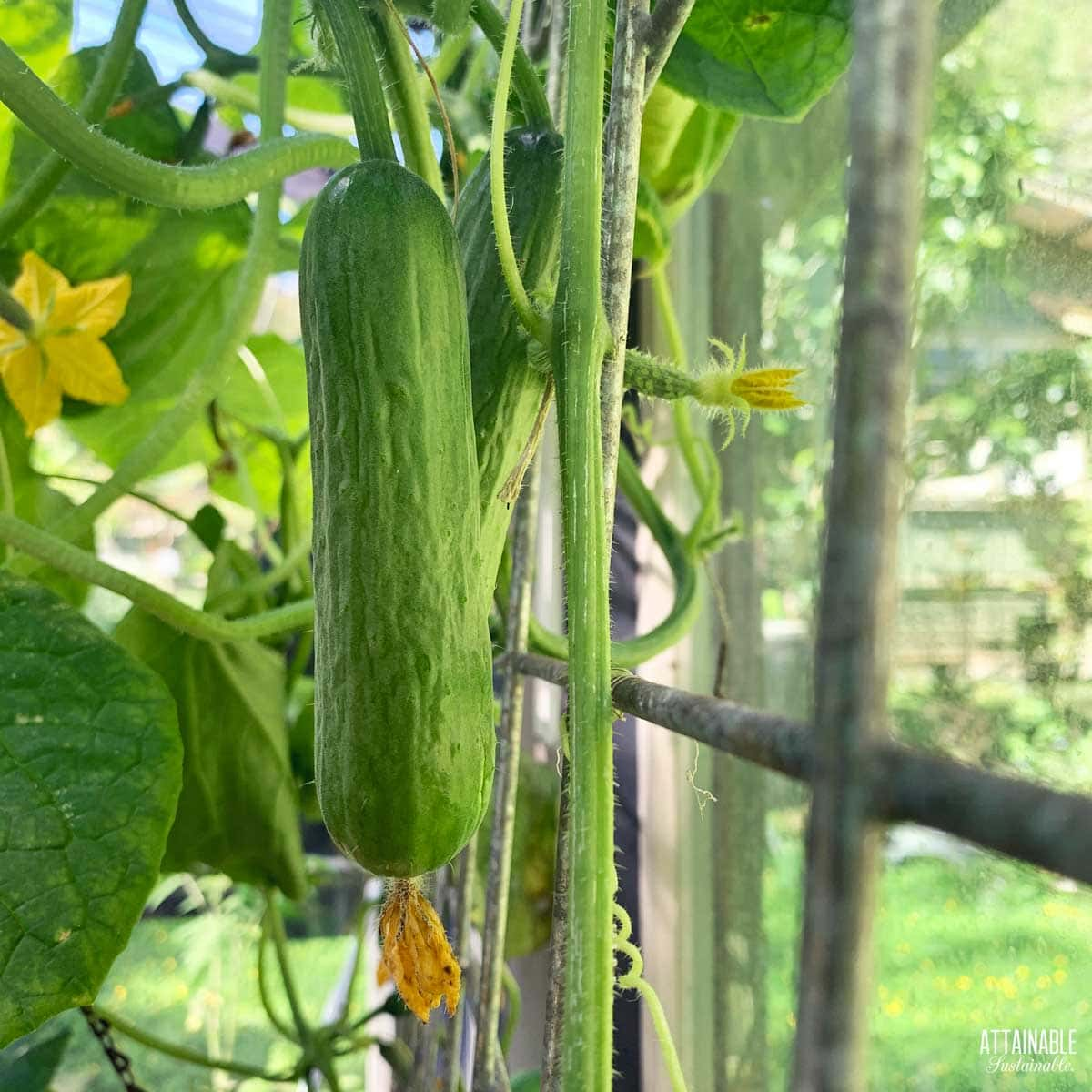
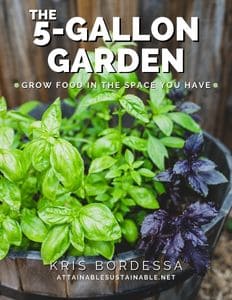

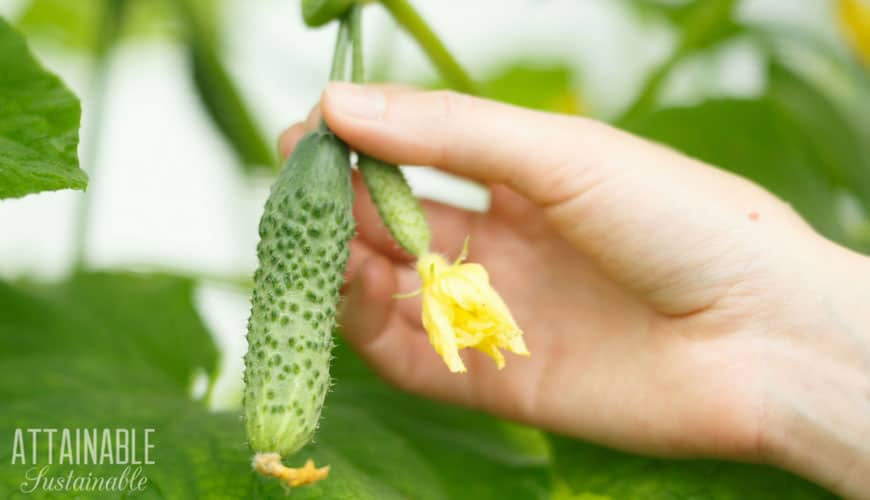
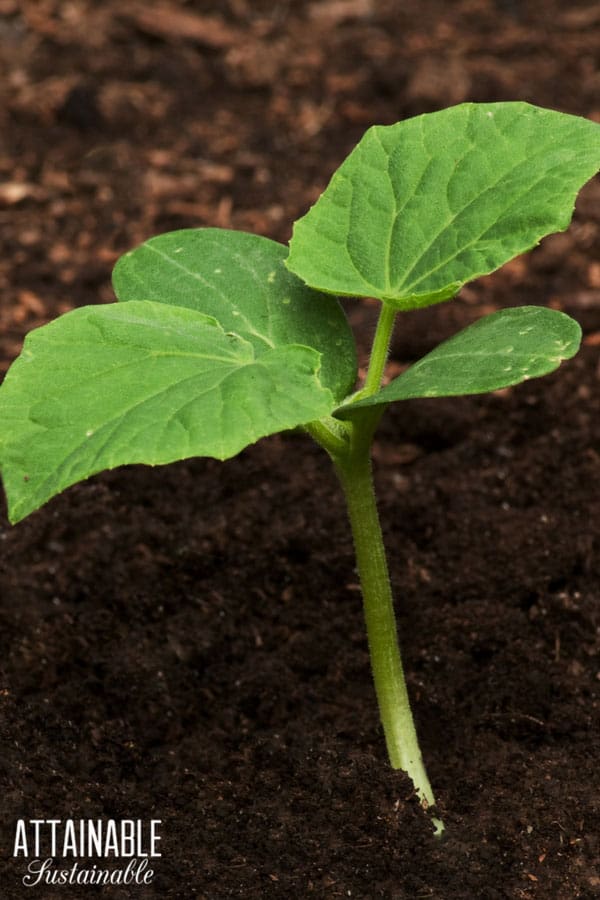

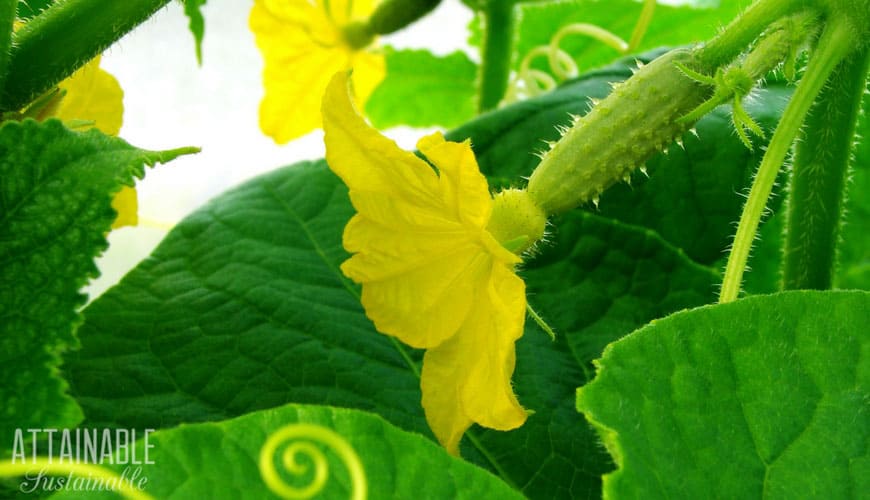
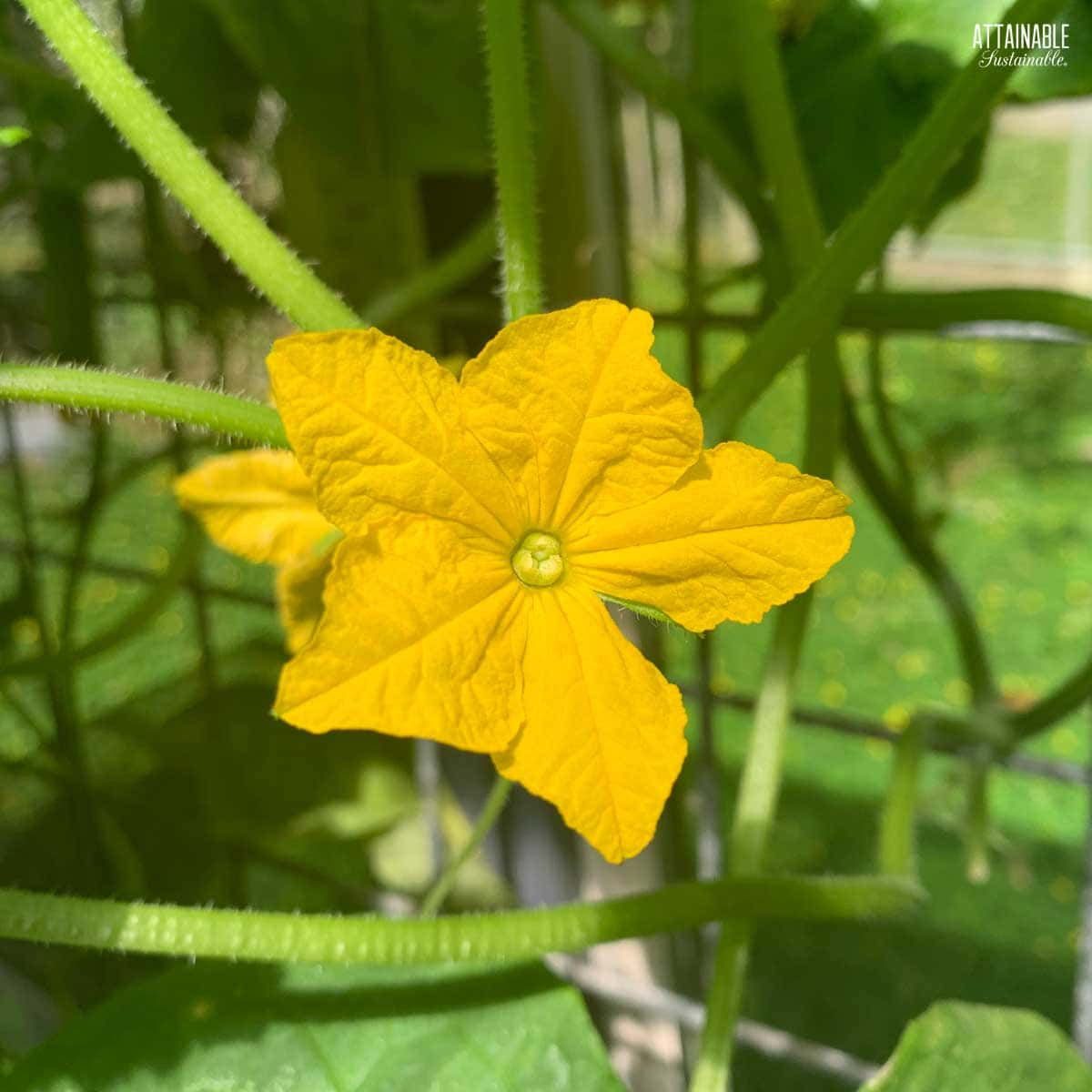
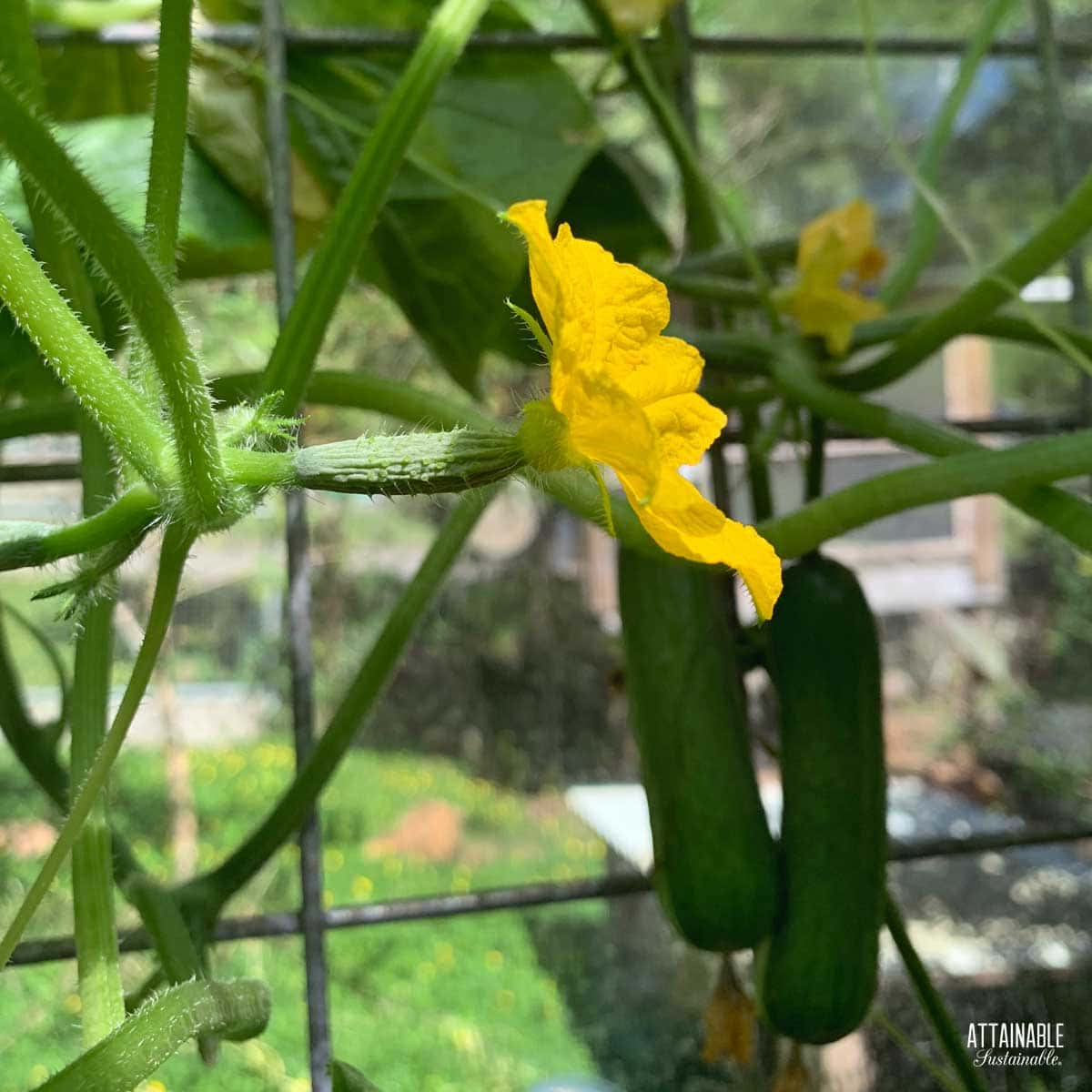

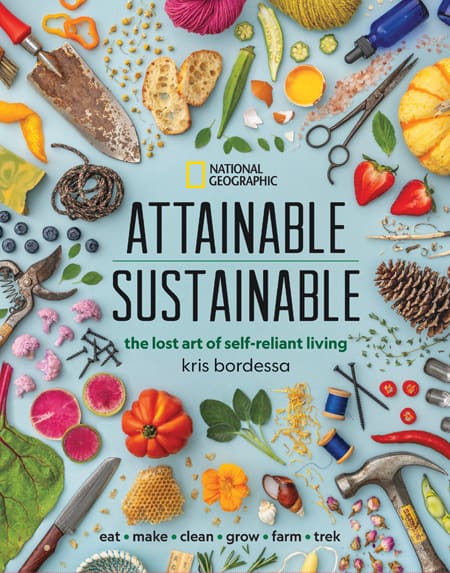
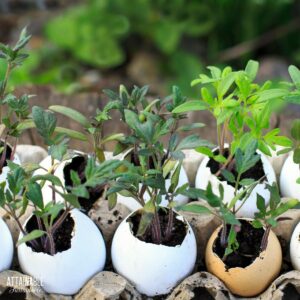
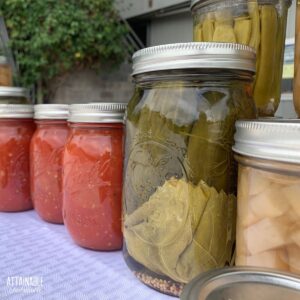
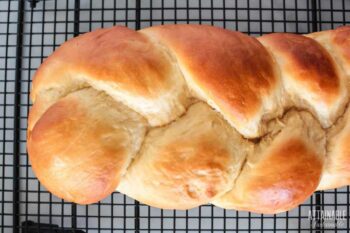
I have elevated garden beds and grow my cucumbers in tomato cages with very good harvests now for 9 years. Two of my beds are made from cinder blocks. Live in Michigan.